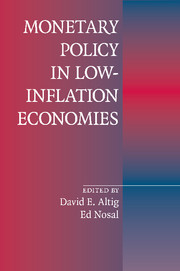Book contents
- Frontmatter
- Contents
- Contributors
- Acknowledgments
- Introduction
- 1 The Welfare Cost of Inflation in the Presence of Inside Money
- Commentary
- 2 An Open-Economy Model of Endogenous Price Flexibility
- Commentary
- 3 Efficient Inflation Targets for Distorted Dynamic Economies
- Commentary
- 4 Inflation and Welfare in Models with Trading Frictions
- Commentary
- 5 Good versus Bad Deflation: Lessons from the Gold Standard Era
- Commentary
- 6 Monetary Policy Orientation in Times of Low Inflation
- Commentary
- 7 Observations on Disinflation in Transition Economies
- Commentary
- 8 Inflation and Financial Market Performance: What Have We Learned in the Last Ten Years?
- Commentary
- Index
2 - An Open-Economy Model of Endogenous Price Flexibility
Published online by Cambridge University Press: 26 January 2010
- Frontmatter
- Contents
- Contributors
- Acknowledgments
- Introduction
- 1 The Welfare Cost of Inflation in the Presence of Inside Money
- Commentary
- 2 An Open-Economy Model of Endogenous Price Flexibility
- Commentary
- 3 Efficient Inflation Targets for Distorted Dynamic Economies
- Commentary
- 4 Inflation and Welfare in Models with Trading Frictions
- Commentary
- 5 Good versus Bad Deflation: Lessons from the Gold Standard Era
- Commentary
- 6 Monetary Policy Orientation in Times of Low Inflation
- Commentary
- 7 Observations on Disinflation in Transition Economies
- Commentary
- 8 Inflation and Financial Market Performance: What Have We Learned in the Last Ten Years?
- Commentary
- Index
Summary
INTRODUCTION
Theoretical studies incorporating nominal rigidities into dynamic general equilibrium models have been developed to an increasing degree of sophistication in recent years (e.g., Woodford 2003). These models have been very influential in making the case for price stability as an optimal monetary policy, both in closed-economy settings as well as in the open economy (e.g., Benigno and Benigno 2003). But in most of these models, the rules used by firms to adjust prices are assumed to be an exogenous part of the environment. Recently, some authors (e.g., Dotsey, King, and Wolman 1999) have pursued a line of research in state-dependent pricing models. In these models, a firm always has an option to adjust its price at any time period, subject to incurring a fixed cost of price change. The firm continually trades off the benefits of adjusting the price against the costs of price change.
This paper develops an intermediate framework between models of fixed prices and models of state-dependent pricing. In this model, firms can choose in advance whether to have flexible prices. By incurring a fixed cost, a firm can invest in flexibility. If the firm incurs this fixed cost, then it can adjust prices ex post in the face of shocks to its demand or marginal cost. If it chooses not to incur this cost, it must set its price in advance. By assuming that firms face differential fixed costs of price flexibility, we can integrate this framework into a general equilibrium model of a small open economy and investigate the determinants of equilibrium price flexibility. In particular, we focus on the relationship between price flexibility and exchange rate policy.
- Type
- Chapter
- Information
- Monetary Policy in Low-Inflation Economies , pp. 29 - 51Publisher: Cambridge University PressPrint publication year: 2009



